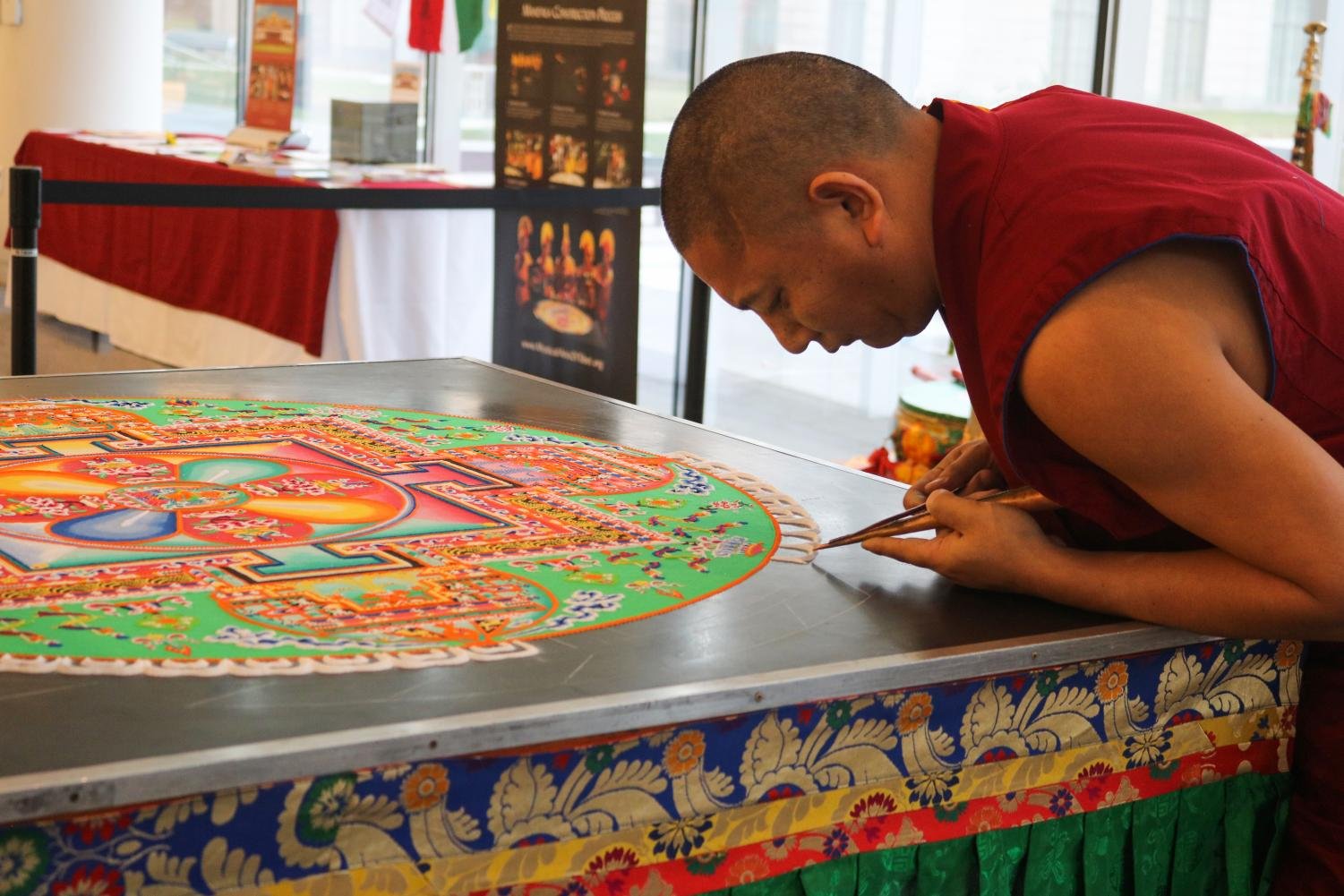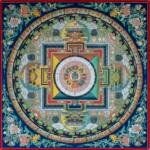Decoding the Vajrayana Mandala
In the profound realms of Vajrayana Buddhism, the Mandala represents the concentrated embodiment of cosmic views, signifying the completeness of the “wheel of enlightenment.” This term extends to the space where Buddhas and Bodhisattvas gather, or the essence of profound realization—a symbol of universal truth and the reality of the Dharma realm. It serves as a spatial expression, linking the macrocosm with the human body or microcosm.
Core Belief of Vajrayana: The Essence of the Mandala
At the heart of the Vajrayana philosophy lies the notion that everything, collectively known as “万法,” is the sacred realm of Buddhas—the Mandala. It emphasizes the purity of phenomena. Regardless of following the stages of life or other paths, practitioners in Vajrayana cannot overlook the crucial concept of Pure Vision. The sequential practice, known as the “五圆满,” revolves around cultivating this Pure Vision. Without it, seeing beings as Buddhas, afflictions as Buddha wisdom, and the inherent purity of the world become unattainable. Therefore, prior to embarking on life stages, the clarity of Pure Vision holds paramount importance.
The Significance of Pure Vision: Insights from the “维摩诘经”
The concept of Pure Vision, a cornerstone of Vajrayana, finds clear articulation in the “维摩诘经.” It acknowledges that the essence of the world isn’t the impure Samsara we perceive, but the pure Buddha land.
Evolution of Perception: From Impurity to Purity
The ordinary world perceived by our five senses is inherently impure. However, through prolonged practice and reaching the Bodhisattva eighth stage, overcoming afflictive and cognitive obstacles, practitioners begin glimpsing the true nature of the world. This reality has two facets: emptiness and a pure world, resembling realms like Sukhavati. These facets, unfortunately, remain obscured due to obstacles and karmic residues in ordinary minds. Recognizing the intrinsic purity of phenomena becomes a crucial viewpoint for Vajrayana practitioners. The term Buddha refers not only to the iconic figures like Amitabha, Medicine Buddha, or Shakyamuni Buddha but, more profoundly, to the Dharmakaya—the true nature of the mind.
Avalokiteshvara: The Embodiment of Compassion
Known as Chenrezig in Tibetan, Avalokiteshvara is the revered Buddhist deity personifying the epitome of compassion. This compassionate being manifests in various forms, with the white deity featuring four or a thousand arms—an expression of Avalokiteshvara’s capacity to aid countless beings simultaneously.
The Sacred Space: Mandala as Divine Residence
The Sand Mandala of Avalokiteshvara, originating from the tantric teachings of Lord Buddha Shakyamuni, serves as the residence for deities and their entourages. Despite its flat depiction, the Mandala transcends dimensions, forming a celestial mansion. At its core resides Avalokiteshvara, surrounded by divine companions.
Symbolic Layers: The Rich Tapestry of the Mandala
Every element within the Mandala holds profound meaning; nothing is arbitrary. The five transparent layers of the outer walls, colored in white, yellow, red, green, and blue, symbolize faith, effort, memory, meditation, and wisdom. These hues also represent the five Dhakinis.
The Four Doorways and Lotus Flower: Portals to Enlightenment
Marking the center of each wall, the four doorways symbolize the Four Immeasurable Thoughts: love, compassion, joy, and equanimity, adorned with precious jewels. The lotus flower at the Mandala’s heart signifies the lotus family, purifying impure states of mind. The white thousand-armed Avalokiteshvara stands on a white moon disk, embodying freedom from attachment.
Deity Retinue and Elemental Purification: A Harmonious Dance
In the four cardinal directions, the retinue of deities sits on white full moon disks. They represent purified aspects of emotions, arising from the unity of Avalokiteshvara’s wisdom of emptiness and great bliss. Each deity corresponds to purified facets—Hatred, Misery, Ignorance, and Jealousy—symbolized by the red, yellow, white, and green petals.
Protective Measures: Vajra Fence and Burning Flames
To shield the divine residence from negativity, a Vajra fence surrounds it, symbolizing the continuous teachings of Vajrayana by Avalokiteshvara. The outermost layer is circled with burning flames, not only offering protection but also eliminating delusion and ignorance with intense light.
A Mandala for Peace and Harmony: Catalyst for Transformation
The Mandala, with its genuine practices of Great Compassion, Wisdom of Emptiness, and deity-focused meditations, becomes a method to bring peace and harmony to our world. By embodying these qualities, practitioners contribute to a positive change in the collective consciousness.
Transformative Meditations: A Gateway to Enlightenment
For practitioners immersed in the Tantra of Avalokiteshvara, familiarity with every Mandala detail is crucial. Visualizing pure beings and environments within the Mandala facilitates profound transformations within the framework of Buddhist wisdom and compassion. Even a fleeting glimpse of the Mandala leaves a positive imprint on the observer’s mind, connecting them momentarily with the potential for perfect Enlightenment inherent in all beings.
Impermanence Ritual: Symbolic Dissolution for Renewal
The ritual’s culmination involves systematically dismantling the Mandala, pouring its sand powder into a river or sea—a poignant reminder of impermanence. This act not only symbolizes the transient nature of the world but also enriches the environment, dispelling untimely death, diseases, and famine.
Embark on this spiritual journey with Avalokiteshvara’s Sand Mandala—a visual symphony of compassion, wisdom, and transformation, resonating with the profound potential for Enlightenment within every being’s mind.
Harmony of Worlds: Mandala as the Unity of All Phenomena
In both worldly and transcendental spheres, everything embodies the Mandala of Buddha’s body, speech, and mind. This intrinsic nature doesn’t require transformation through practices; it inherently exists. “世间” represents the visible world we perceive, while “出世间” pertains to the enlightened realms realized by Buddhas and Bodhisattvas. Vajra signifies the inseparable unity—every being’s body, speech, and mind are fundamentally undivided from those of the Buddha. Recognizing that beings embody Buddha’s essence is the essence of Vajrayana wisdom.
Conclusion: Embracing Pure Vision for Spiritual Enlightenment
In summary, unraveling the mysteries of the Vajrayana Mandala unveils a profound journey from impurity to purity, from ordinary perception to the recognition of Buddha’s essence in all phenomena. Embracing Pure Vision becomes not just a practice but a transformative perspective that guides practitioners toward spiritual enlightenment.
















